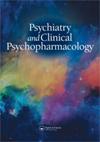土耳其游戏障碍测试的心理测量验证:根据世界卫生组织框架评估游戏障碍的措施
IF 0.5
4区 医学
Q4 PHARMACOLOGY & PHARMACY
引用次数: 8
摘要
目的:先前对游戏障碍(GD)的研究使用心理测量工具,根据美国精神病学协会(APA)诊断框架进行评估。游戏障碍测试(GDT)是根据世界卫生组织(WHO)诊断框架评估游戏障碍症状和流行程度的标准化措施。当前研究的主要目的是使GDT适应土耳其语。方法:在本研究中,研究人员使用GDT、网络游戏障碍简易量表(IGDS9-SF)和cage -问题网络使用问卷(CAGE-PIUQ)对参与者进行评估。采用验证性因子分析(CFA)对量表的因子结构进行检验,并进行信度和效度分析。结果:共收集932名土耳其游戏玩家,其中58.3%为男性,平均年龄23.64岁,SD=5.42。验证性因子分析表明,GDT的单维因子结构是令人满意的。量表也是可靠的(即,内部与Cronbach's alpha为0.879一致),并显示出足够的收敛效度和标准相关效度,如去年平均每天花在玩游戏上的时间(ATDSPG), IGDS9-SF和CAGE-PIUQ分数之间的统计学显著正相关。通过应用国际疾病分类第11版(ICD-11)诊断GD的阈值(例如,通过回答“经常”[4]或“非常经常”[5]来满足所有四个标准),发现GD的患病率为1.9% (n = 18)。结论:网络游戏偏好、ATDSPG和可能的ADHD预测了游戏障碍的严重程度。这些发现支持土耳其版本的GDT作为一种有效和可靠的工具,用于确定年轻人中GD相关问题的程度,并用于临床环境和类似研究中的早期GD诊断。本文章由计算机程序翻译,如有差异,请以英文原文为准。
Psychometric Validation of the Turkish Gaming Disorder Test: A Measure That Evaluates Disordered Gaming According to the World Health Organization Framework
PURPOSE: Previous research on gaming disorder (GD) used psychometric tools, which evaluates according to the American Psychiatric Association (APA) diagnostic framework. The Gaming Disorder Test (GDT), a standardized measure to assess symptoms and prevalence of GD according to the World Health Organization (WHO) diagnostic framework. The main aim of the current study was to adapt GDT to Turkish. METHOD: In the present study participants were assessed with the GDT, the Internet Gaming Disorder ScaleShort-Form (IGDS9-SF), and the CAGE-Problematic Internet Use Questionnaire (CAGE-PIUQ). The factor structure of the scale was tested with Confirmatory Factor Analysis (CFA), and reliability and validity analyses were conducted. The method used in the study, and the scale adaptation, RESULTS: A sample of 932 Turkish gamers (58.3% male, mean age 23.64 years, SD=5.42) was recruited online. Confirmatory factor analyses demonstrated that the unidimensional factor structure of the GDT was satisfactory. The scale was also reliable (i.e., internally consistent with a Cronbach's alpha of 0.879) and showed adequate convergent and criterion-related validity, as indicated by statistically significant positive correlations between average time daily spent playing games (ATDSPG) during last year, IGDS9-SF and CAGE-PIUQ scores. By applying the International Classification of Diseases 11th edition (ICD-11) threshold for diagnosing GD (e.g., meeting all four criteria by answering them either with often [4] or very often [5]), it was found that the prevalence of GD is 1.9% (n = 18). CONCLUSION: Online gaming preference, ATDSPG and probable ADHD predicted the severity of disordered gaming. These findings support the Turkish version of the GDT as a valid and reliable tool for determining the extent of GD related problems among young adults and for the purposes of early GD diagnosis in clinical settings and similar research.
求助全文
通过发布文献求助,成功后即可免费获取论文全文。
去求助
来源期刊

Psychiatry and Clinical Psychopharmacology
Medicine-Psychiatry and Mental Health
CiteScore
1.00
自引率
14.30%
发文量
0
期刊介绍:
Psychiatry and Clinical Psychopharmacology aims to reach a national and international audience and will accept submissions from authors worldwide. It gives high priority to original studies of interest to clinicians and scientists in applied and basic neurosciences and related disciplines. Psychiatry and Clinical Psychopharmacology publishes high quality research targeted to specialists, residents and scientists in psychiatry, psychology, neurology, pharmacology, molecular biology, genetics, physiology, neurochemistry, and related sciences.
 求助内容:
求助内容: 应助结果提醒方式:
应助结果提醒方式:


